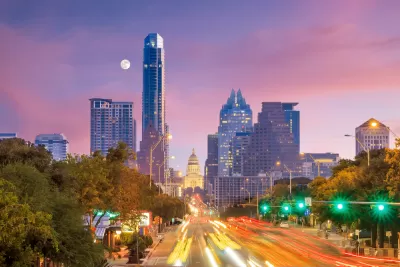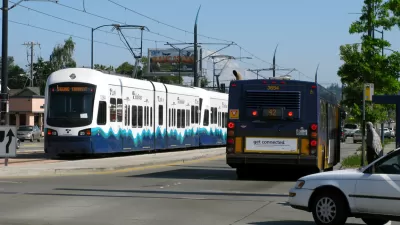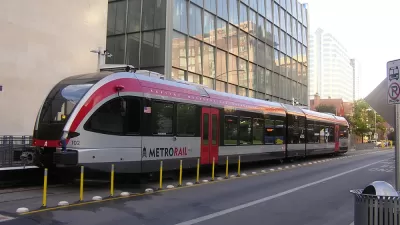Project Connect promises to prioritize equity and inclusion with $300 million dedicated to anti-displacement efforts.

Austin's newly approved $7 billion transit expansion plan boasts an ambitious set of goals that, according to Mayor Steve Adler, meets "so many long-held needs." The project will expand bus and electric bike share services, build a transit tunnel, and install almost ten miles of commuter rail.
While efficient and popular with transportation planners, light rail has a darker connotation for many community activists like Susana Almanza. Almanza, who serves as director of environmental justice organization PODER, worries about the effects of the new transit infrastructure on local communities, citing a history of displacement that frequently follows new rail lines. As transit-adjacency transforms from an undesirable reality to a highly valued urban amenity, low-income communities near rail lines become displaced by luxury housing developments aimed at upwardly mobile workers. An NRDC study of California's major urban areas found that rent for a two-bedroom apartment within a half-mile of a transit stop averaged more than $3,000, well above affordability for most transit-dependent families.
Austin's leaders are addressing these concerns head-on with an equity plan and dedicated budget aimed at helping low-income residents stay in their homes and reducing the negative impacts of rail construction. The budget includes rent subsidies and homeowner assistance to help the communities that rely on transit the most and offset the neighborhood change inevitably brought by new transit infrastructure. As part of the equity plan, the city plans to create a neighborhood-level equity assessment tool and community advisory committee that will monitor performance progress once projects are underway.
FULL STORY: The next challenge for Austin’s transit plan: Delivering on its equity pledge

Planetizen Federal Action Tracker
A weekly monitor of how Trump’s orders and actions are impacting planners and planning in America.

Restaurant Patios Were a Pandemic Win — Why Were They so Hard to Keep?
Social distancing requirements and changes in travel patterns prompted cities to pilot new uses for street and sidewalk space. Then it got complicated.

Map: Where Senate Republicans Want to Sell Your Public Lands
For public land advocates, the Senate Republicans’ proposal to sell millions of acres of public land in the West is “the biggest fight of their careers.”

Maui's Vacation Rental Debate Turns Ugly
Verbal attacks, misinformation campaigns and fistfights plague a high-stakes debate to convert thousands of vacation rentals into long-term housing.

San Francisco Suspends Traffic Calming Amidst Record Deaths
Citing “a challenging fiscal landscape,” the city will cease the program on the heels of 42 traffic deaths, including 24 pedestrians.

California Homeless Arrests, Citations Spike After Ruling
An investigation reveals that anti-homeless actions increased up to 500% after Grants Pass v. Johnson — even in cities claiming no policy change.
Urban Design for Planners 1: Software Tools
This six-course series explores essential urban design concepts using open source software and equips planners with the tools they need to participate fully in the urban design process.
Planning for Universal Design
Learn the tools for implementing Universal Design in planning regulations.
Heyer Gruel & Associates PA
JM Goldson LLC
Custer County Colorado
City of Camden Redevelopment Agency
City of Astoria
Transportation Research & Education Center (TREC) at Portland State University
Camden Redevelopment Agency
City of Claremont
Municipality of Princeton (NJ)





























